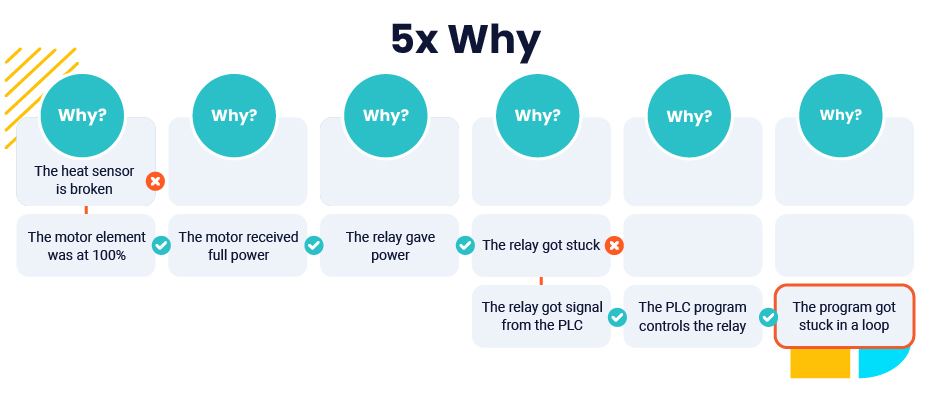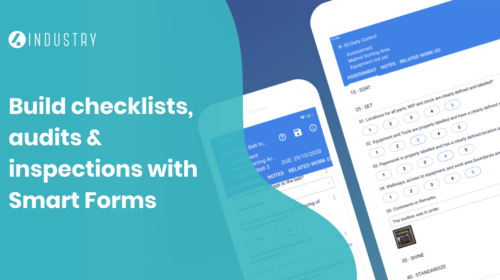
The 5 Whys Method: Explanation, How to use It, and Examples
Learn what the 5 whys method is, what it’s used for and how you can use it in practice.

What is the 5 whys method?
The 5 whys (or five whys) method is a root cause analysis tool in manufacturing that helps pinpoint a problem’s cause by asking the question why? multiple times. Each question leads to another question, forming a chain of cause-and-effect that gradually gets closer to the root cause.
Although five is considered to be the number that’s generally sufficient to reach a problem’s root cause, it’s possible for more (or less) questions to be necessary to complete an analysis.
A problem can, moreover, have multiple root causes, necessitating the 5 whys chain to be separated into multiple layers or the entire analysis to be repeated several times.
The five whys technique can be used to get to the bottom of a large variety of problems, from simple day-to-day mishaps to relatively complex, multi-layered problems.
In this article, we’ll explain its use as a problem-solving tool in manufacturing.
When is the 5 whys technique used?
The 5 whys method is useful to eliminate unfounded assumptions, inconsistent logic and preconceived conclusions from a problem-solving effort.
Instead, a structured, logically intact chain of cause and effect is formed that progressively penetrates to a problem’s root cause. If the root cause is eliminated, the causes in the 5 whys chain should in turn disappear.
The 5 whys technique is a common problem-solving tool in manufacturing; it is an important component of lean manufacturing, Six Sigma and Kaizen. The aim of any root cause analysis is to locate and fix the main cause that underlies a problem.
How to do a 5 whys analysis in 4 steps
Here’s a concise 4-step plan for performing a 5 whys analysis.
In the paragraph following this one, we’ll list some of the key things you should keep in mind during your analysis.
1. Bring together a team of troubleshooters
As said above, unfounded assumptions and inconsistent logic are hazardous to the integrity of this technique.
Bringing together a team of relevant experts is a way of safeguarding the consistency of the 5 whys method.
2. Define the problem you want to investigate
A 5 whys analysis should always be preceded by a process in which the problem is clearly defined and demarcated.
There are other RCA tools you can use during this phase—we discuss some of them in this blog.
3. Start forming your chain of whys
Time to start asking questions! Formulate your questions on the basis of facts and/or data—in other words: your questions should relate to what actually happened, not to what you assume happened.
Questions and answers can simply be written down on a whiteboard or piece of paper.
Formulate your questions and answers in a clear way; avoid wordy phrases and vague statements. Make sure your team agrees on the correctness of the questions, answers and concluding root cause.
Enter your questions beside your initial problem; with each question and answer, your 5 whys chain will lengthen.
It’s important to emphasize that a problem might have multiple potential root causes and that your 5 whys chain can accordingly be split up into multiple layers.
Keep repeating this until the root cause of the problem is found. Persistence is important here, but you should also be aware of when to stop.
Giving up early will naturally cause the analysis to fail; going on for too long might cause you to get sidetracked or end up with the wrong result.
4. Implement changes and see if the problem is resolved
If you think you’ve reached the root cause of the problem, you should implement changes and see if they are effective. If not, the root cause may be different, prompting you to open up another layer in the 5 whys chain or start an entirely new analysis.
Pro tip
After a successful analysis, your troubleshooting team should see if general measures or procedures can be set up to prevent similar problems from occurring in the future.
Important things to remember
- The question “why?” can be repeated as often as is necessary
- To ensure the logical integrity of an analysis, the chain can be run through in the opposite direction
- Avoid mixing up causes with symptoms
An example of a 5 whys analysis
Let’s run through a quick example of a 5 whys analysis to see how one is performed in practice.

In the above image, the main problem is stated in the upper left corner. Four initial questions are asked until the troubleshooters reach the first indicator of the root cause: the relay got stuck.
This observation opens up an additional, more specific layer of questions that focus on the relay. Two more questions are needed to reach the root cause: the program got stuck in a loop. Note how the chain can be run from root cause to problem in a logically coherent way.
Pros and cons of the 5 whys method
Pros
- Effective and simple investigative method
- Easy to make
- Helps determine a problem’s root cause
- Can help uncover the interrelation between multiple root causes
- Gives insight into the chain of cause and effect underlying a problem
Cons
- Complex problems might require the use of additional RCA tools
- The effectiveness depends on the know-how and tenacity of troubleshooters; good data may also be required
- There aren’t definite guidelines on what questions should be asked
Related Articles

Knowledge Management on the factory floor

Work on tasks from an easy-to-use Task Management system

